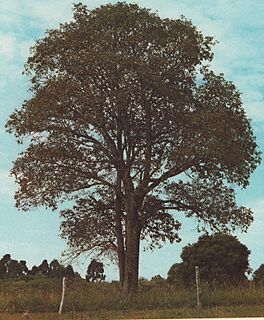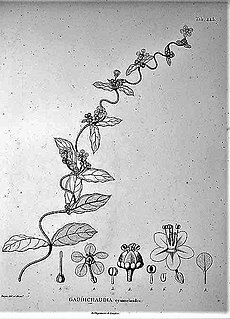
Clintonia is a genus of flowering plants in the lily family Liliaceae. Plants of the genus are distributed across the temperate regions of North America and eastern Asia, in the mesic understory of deciduous or coniferous forests. The genus, first described by Constantine Samuel Rafinesque in 1818, was named for DeWitt Clinton (1769–1828), a naturalist and politician from the U.S. state of New York. For this reason, plants of the genus are commonly known as Clinton's lily. The common name bluebead refer to the distinctive fruit of members of the genus. Since fruit color varies somewhat across species, the common name bead lily is used as well.
Arthur Francis George Kerr (1877–1942) was an Irish medical doctor. He is known particularly now for his botanical work, which was important for the study of the flora of Thailand.

Luehea is a genus of trees in the family Malvaceae.
Dahliaphyllum is a genus of flowering plants belonging to the family Apiaceae.
Gonzalezia is a genus of flowering plants belonging to the family Asteraceae.
Johnstonella is a genus of flowering plants belonging to the family Boraginaceae.
Ibervillea is a genus of flowering plants belonging to the family Cucurbitaceae.
Helmiopsis is a genus of flowering plants belonging to the family Malvaceae.
Helmiopsiella is a genus of flowering plants belonging to the family Malvaceae.
Escobedia is a genus of flowering plants belonging to the family Orobanchaceae.
Hoverdenia is a monotypic genus of flowering plants belonging to the family Acanthaceae. It only contains one species, Hoverdenia speciosa.
Kearnemalvastrum is a genus of flowering plants belonging to the family Malvaceae.
Lundia is a genus of flowering plants belonging to the family Bignoniaceae.
Erblichia is a monotypic genus of flowering plants belonging to the family Passifloraceae. The only species is Erblichia odorata.
Hunzikeria is a genus of flowering plants belonging to the family Solanaceae.
Johnstonalia is a monotypic genus of flowering plants belonging to the family Rhamnaceae. The only species is Johnstonalia axilliflora(M.C.Johnst.) Tortosa
Kadenicarpus is a genus of flowering plants belonging to the family Cactaceae.

Gaudichaudia is a genus of flowering plants belonging to the family Malpighiaceae.

Gaya is a genus of flowering plants belonging to the family Malvaceae. It has been classed in the Malvoideae subfamily and the Malveae tribe.
Hanburia is a genus of plants in the tribe Sicyoeae of the gourd family, Cucurbitaceae. Its native range is from Mexico to Venezuela and Peru. It is found in the countries of Colombia, Costa Rica, Ecuador, Guatemala, Honduras, Mexico, Panamá, Peru and Venezuela.




